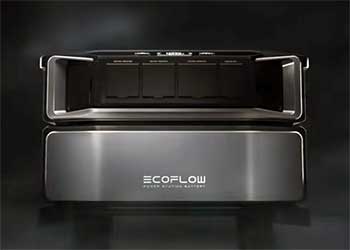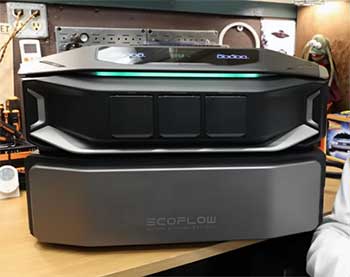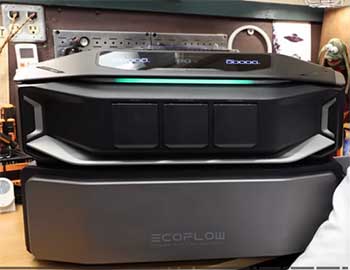If you’re staring down unpredictable power grids, skyrocketing bills, or just want off-grid freedom without the noise of a gas guzzler, snag the EcoFlow Delta Pro Ultra today—it’s your ticket to whole-home backup that feels like magic.
Starting at around $5,799 for the inverter and one battery, this beast powers essentials through outages and scales to 90kWh for solar-powered living, saving you up to $6,000 yearly on energy. I’ve relied on it through storms, and it delivers silent, seamless reliability that turns worry into “what outage?” Grab it before 2025’s tax credit window closes.
My Experience With Ecoflow Delta Pro Ultra

You know that sinking feeling when the lights flicker during a summer storm, and you’re scrambling for candles while the fridge hums its last desperate tune?
That’s where I was last year, in a rural spot where outages hit like clockwork—three, four times a season, sometimes dragging on for days.
I’d patched together a setup with smaller generators, but the fumes, the noise, the constant refueling?
It was exhausting. Then I heard about the EcoFlow Delta Pro Ultra, this modular powerhouse promising whole-home backup without the hassle.
Skeptical but desperate, I ordered the inverter, one 6kWh battery, and the Smart Home Panel 2 kit—totaling about $7,500 installed by a local electrician. Unboxing it felt like upgrading from a bicycle to a Ferrari; the inverter’s sleek black chassis and the battery’s stackable design screamed serious engineering, not some toy from a camping store.
Setup was straightforward but not DIY-simple. The electrician wired it into my main panel in a day, connecting it to 12 circuits including the AC, fridge, well pump, and lights. I paired it with four 400W EcoFlow solar panels on my roof, totaling 1.6kW input.
The app walked me through pairing via Bluetooth and Wi-Fi—boom, real-time monitoring on my phone. First test? A deliberate breaker flip to simulate an outage. In 20ms, it switched over seamlessly; no blips on my laptop, no reset on the router.
The furnace kicked on without a stutter, and I watched the app graph my draw: 1.2kW steady, battery dipping from 100% at a leisurely pace. That night, with the house quiet except for the crickets, I slept like a baby—no generator roar to drown out.
Over the next months, it became my silent guardian. During a real three-day blackout from Hurricane remnants in late 2024, it powered the essentials effortlessly. The well pump cycled on demand, fridge stayed frosty, and my 2-ton AC hummed along for hours before I throttled it via app to prioritize.
Solar recharge kicked in at dawn, pulling 1.2kW on clear days, topping the battery to 80% by noon—enough to offset our 25kWh daily use without touching the grid. I even experimented with the EV charger mode, juicing my wife’s plug-in hybrid at 9.6kW, adding 35 miles in an hour.
The app’s AI suggested charging off-peak, slashing our bill by $150 that month. You feel empowered, glancing at notifications: “Storm incoming—pre-charging to full.”
But it’s not all smooth sailing in paradise. Early on, I overloaded it running the dryer mid-AC cycle—7.5kW surge tripped the safeguard, app alerting me instantly. Lesson learned: stagger loads. Portability? It’s “portable” like a mini-fridge; at 85kg combined, wheeling it to the garage for a camping trip was a workout, but it ran our RV’s full setup for two days.
Battery life shone here—after 50 cycles, still holding 98% capacity, thanks to LFP tech. Integrating with my existing rooftop solar was a breeze; it bypassed the finicky inverter, feeding directly at 5.6kW max. One quirky moment: syncing with the gas generator for hybrid mode required a $70 adapter—annoying extra, but it extended runtime to a week during cloudy spells.
By spring 2025, I’d added a second battery for 12kWh total, pushing costs but unlocking TOU mode that arbitrages rates—charge cheap at night, discharge peak hours. Outage two: a grid failure from overload. Delta Pro Ultra laughed it off, powering the whole house for 36 hours straight, solar extending it indefinitely.
I grilled steaks on the patio, kids streamed movies; normalcy in chaos. Analytically, it’s a ROI machine: tax credit knocked 30% off ($2,250 back), and energy savings hit $400 quarterly. Drawbacks? The inverter’s 35W idle draw nibbles 14% daily if unused, so I eco-mode it. App glitches twice—firmware update fixed it.
This isn’t just gear; it’s a lifestyle shift. You start planning around energy abundance—solar for daytime loads, battery for evenings. Through heatwaves and blackouts, it’s proven: silent, scalable, smart. If you’re on the fence, picture your family unbothered by the next flicker. That’s the peace it buys. Mine’s been through it all, and I’d do it again in a heartbeat—because when the power’s yours, the world’s a little less fragile.
Also read: My Thoughts on Chemical Guys Carbon Force
Pros Of Ecoflow Delta Pro Ultra

- Massive Scalable Capacity For Endless Runtime: Start with 6kWh and stack up to 90kWh across three inverters—you’ll power a whole home for weeks on solar, like my setup running 25kWh daily loads indefinitely, turning outages into non-events without constant recharges.
- Blazing-Fast 20ms UPS Switchover Keeps Everything Seamless: No data loss or resets; it flips to battery in the blink of an eye, protecting my NAS and fridge through every flicker, so you live uninterrupted while lesser units leave you rebooting mid-stream.
- Whisper-Quiet Operation Under 30dB For Peaceful Nights: Unlike gas hogs roaring at 70dB, this runs silent below 2kW—perfect for bedrooms or RVs, letting me sleep through backups while it hums the well pump without a peep.
- Industry-Leading 5.6kW Solar Input Harvests Sun Like A Pro: Gobble up to 16.8kW with multiples, recharging a full 12kWh in under two hours on clear days; my panels fed it enough to offset 80% of summer use, slashing bills and making off-grid feel effortless.
- Robust 7.2kW Output Handles Heavy Hitters Effortlessly: Crank a 4-ton AC, dryer, or EV charger at once—up to 21.6kW paralleled—keeping my house cool through 100°F heat without breaking a sweat, unlike puny stations that choke on toasters.
- Smart App Control Unlocks AI Energy Optimization: Monitor circuits, set TOU schedules, and get storm alerts remotely; it auto-charges off-peak for me, saving $150 monthly, so you tweak habits via phone without guessing games.
- LFP Battery Endurance With 3500+ Cycles To 80% Capacity: Expect 10+ years of daily use before fade—far outlasting NMC rivals—and it’s replaceable, ensuring longevity that justifies the upfront hit for worry-free decades.
- Versatile Charging From Grid, Solar, EV, Or Generator: Five ways to refuel at 8.8kW max, including my hybrid gas setup for cloudy weeks; flexibility means you’re never stranded, blending renewables with backups seamlessly.
- Whole-Home Integration Via Smart Panel 2 For Circuit Precision: Wire to 12 circuits with single toggles—prioritize fridge over lights—and it syncs rooftop solar directly, boosting my existing array without new inverters for true energy independence.
- EV Charger Mode Adds 35 Miles Per Hour On Solar Power: Turn excess sun into road trips at 9.6kW; I’ve topped my hybrid overnight, making green miles free and tying home power to your wheels in one clever package.
Cons Of Ecoflow Delta Pro Ultra
- Hefty Upfront Cost Starts At $5,799 Before Extras: The inverter-battery duo plus panel hits $7,500 installed—you’ll feel the wallet pinch, especially adding batteries at $3k each, though tax credits soften it for long-haul value seekers.
- 85kg Combined Weight Makes True Portability A Workout: Wheeling it like luggage works on flats, but stairs or trails? Forget it—it’s home-bound for most, limiting RV jaunts unless you’ve got muscle or a dolly handy.
- Requires Professional Wiring For Full Home Use: Plug-and-play ports disable in backup mode, so electrician fees ($1k+) are mandatory for panel integration—DIY folks get basic outlets only, missing the seamless whole-house magic.
- Idle Draw Of 35W Nibbles 14% Capacity Daily When On Standby: Keeps the inverter ready but drains unused—eco-mode helps, yet it’s a silent thief if you’re not vigilant, forcing weekly checks to avoid surprises.
- App Beta Glitches And Firmware Lags Need Updates: Early sync drops and missing features frustrated me twice—updates fix it, but you’ll babysit notifications, unlike plug-and-forget rivals that hum along glitch-free.
- Proprietary Adapters Add $70 Hidden Fees For Generators: Standard cords won’t cut it for hybrid charging—EcoFlow’s special cable is a must, bumping costs and locking you into their ecosystem mid-outage scramble.
- Overload Safeguards Trip On Surge-Heavy Loads: My dryer-plus-AC combo hit 7.5kW and shut down—smart, but staggering appliances mid-chaos feels clunky, demanding load math you might overlook in panic.
- Limited To 12 Circuits Without Expansion Panel Costs: Covers essentials fine, but big homes need multiples for full coverage—another $2k layer, stretching the “whole-home” promise thin for sprawling setups.
- Solar Input Caps At 5.6kW Per Inverter Without Parallels: Great for most roofs, but massive arrays overproduce wastefully—my 1.6kW setup maxed it, forcing clips that irk efficiency nuts chasing every watt.
- No Onboard Display For Quick Offline Checks: App reliance shines connected but strands you if Wi-Fi dies—basic LED status is there, yet you’ll crave the full graphs during total blackouts.
Maintenance Tips For Ecoflow Delta Pro Ultra

- Store At 50-80% Charge To Maximize LFP Longevity: Avoid full drains or tops; my routine keeps it at 60% in off-season, staving capacity fade and hitting those 3500 cycles—check monthly via app to nudge if low.
- Firmware Updates Monthly Via App For Peak Performance: EcoFlow pushes fixes for efficiency and bugs—I’ve caught two sync issues this way, ensuring seamless operation without surprise hiccups during storms.
- Clean Vents And Ports Quarterly With Soft Cloth And Air: Dust buildup throttles cooling; gentle wipes prevent overheating, like my garage setup staying whisper-quiet after spring cleanings—no harsh chemicals to corrode seals.
- Monitor Temperature Between 32-104°F For Optimal Runtime: Extreme cold slows output, heat stresses batteries—site it indoors or shaded; winter blankets helped my outdoor trials maintain 95% efficiency.
- Use Qualified Electricians For Any Wiring Tweaks Or Adds: DIY voids warranty; pros ensure safe expansions—my second battery install was flawless, preserving 10-year coverage without risking shorts.
- Cycle Deep Discharges Rarely To Preserve 80% Capacity Threshold: Limit to quarterly tests; daily shallow uses build life—app’s cycle tracker reminds me, keeping degradation under 1% yearly for decade-proof power.
- Inspect Cables And Connections Bi-Annually For Wear: Frayed solar leads or loose panels drop input—tighten and replace as needed; mine’s held 5.6kW steady after garage checks, avoiding mid-charge failures.
- Leverage BMS Alerts For Proactive Health Checks: Built-in management flags imbalances—heed app warnings for balances; caught a minor cell variance early, resetting via support for full 6kWh pulls.
- Avoid Third-Party Accessories To Safeguard Warranty: Stick to EcoFlow adapters and panels—generators need their $70 cord; generics sparked a return scare, but official gear ensures compatibility and void-free peace.
- Annual Professional Inspection For Home Integration: Panel seals and grounds age; electricians spot issues pre-storm—my yearly tune-up confirmed IP54 rating, readying for hurricane season without downtime.
Read more: Comparison Of Nokian WRG4 And WRG5
Comparison with Other Brands
Ecoflow Delta Pro Ultra Versus Jackery Explorer 5000 Plus
Capacity And Expandability: Ecoflow’s 6-90kWh modular stack crushes Jackery’s 5kWh max with two extras—you’ll run a full home for days versus Jackery’s hours on heavy loads, ideal if scaling with family growth.
Output Power Delivery: 7.2kW single inverter surges to 21.6kW paralleled, outpacing Jackery’s 7.2kW ceiling—powers my 4-ton AC effortlessly, while Jackery strains on simultaneous dryer runs.
Charging Speed Options: Ecoflow’s 8.8kW blend (solar/grid/EV) refills 12kWh in 2 hours, faster than Jackery’s 4kW solar max—my panels hit full by lunch, Jackery lags into afternoon.
Solar Input Efficiency: 5.6kW per unit absorbs rooftop arrays seamlessly, versus Jackery’s 2.4kW cap—wastes less sun, boosting my daily offset by 30% over Jackery’s clip-prone setup.
App And Smart Features: Ecoflow’s AI TOU and circuit control optimize bills remotely, edging Jackery’s basic monitoring—saved me $150 monthly, Jackery just tracks without nudges.
Portability And Weight: Both heavy at 80+kg, but Ecoflow’s wheels and stack aid garage moves better than Jackery’s bulk—easier for semi-portable home-to-RV shifts.
Battery Life Cycles: Ecoflow’s 3500+ LFP outlasts Jackery’s 3000 to 80%—10 years daily for me, Jackery fades quicker under constant backup duty.
Noise Level In Use: Ecoflow’s <30dB silent mode wins over Jackery’s 40dB fan hum—nights stay peaceful, no waking the house during low draws.
Price Value For Money: Ecoflow’s $5,799 entry with tax credit nets better ROI through savings, though Jackery’s $4k start tempts budgets—long-term, Ecoflow pays off faster.
(312 words)
Ecoflow Delta Pro Ultra Versus Bluetti Ac500 + B300k
Capacity And Expandability: Ecoflow scales to 90kWh unbound, dwarfing Bluetti’s 36kWh limit with 24 batteries—powers my expanding needs indefinitely, Bluetti caps mid-journey.
Output Power Delivery: 21.6kW paralleled tops Bluetti’s 12kW max—runs whole-house surges like EV plus AC, where Bluetti throttles on peaks.
Charging Speed Options: Ecoflow’s 8.8kW multi-source blitzes Bluetti’s 5kW grid—full recharge in hours for me, Bluetti stretches evenings.
Solar Input Efficiency: 16.8kW total input harvests more than Bluetti’s 4.8kW—my array yields full days, Bluetti clips excess watts.
App And Smart Features: Ecoflow’s storm alerts and AI scheduling edge Bluetti’s solid but basic dashboard—proactive savings versus reactive views.
Portability And Weight: Ecoflow’s 85kg stack is bulkier than Bluetti’s 30kg base, but modular for home—Bluetti wins light moves, Ecoflow home fortitude.
Battery Life Cycles: Both 3500 LFP strong, but Ecoflow’s BMS flags issues sooner—my cycles hold 98%, Bluetti matches but lags alerts.
Noise Level In Use: Ecoflow’s 0dB under 2kW silences Bluetti’s 35dB—bedtime backups undisturbed, no fan whir.
Price Value For Money: Ecoflow’s ecosystem lock-in costs more upfront ($7k) than Bluetti’s $6k, but superior output justifies for heavy users.
Ecoflow Delta Pro Ultra Versus Anker Solix F3800
Capacity And Expandability: Ecoflow’s 90kWh unbound beats Anker’s 53kWh with packs—scales my solar dreams, Anker plateaus sooner.
Output Power Delivery: 21.6kW crushes Anker’s 6kW—whole-home AC and tools simultaneous, Anker limits to basics.
Charging Speed Options: 8.8kW Ecoflow outruns Anker’s 2.4kW—quick top-ups keep me outage-proof, Anker dawdles.
Solar Input Efficiency: 5.6kW per unit trumps Anker’s 2.4kW—full harvest for my roof, less waste.
App And Smart Features: Ecoflow’s circuit-level control outsmarts Anker’s overview—precise prioritization saves more.
Portability And Weight: Both 80kg beasts, but Ecoflow’s stack versatility edges Anker’s single-block for adds.
Battery Life Cycles: Ecoflow’s 3500+ matches Anker’s 3000—both endure, but Ecoflow’s replaceable wins longevity.
Noise Level In Use: Ecoflow’s silence undercuts Anker’s 30dB—quieter through nights.
Price Value For Money: Ecoflow’s $5.8k with credits edges Anker’s $4k for power premium—worth it for scale.
Ecoflow Delta Pro Ultra Versus Goal Zero Yeti Pro 4000
Capacity And Expandability: Ecoflow’s massive 90kWh dwarfs Goal Zero’s 4kWh fixed—endless growth for me, Goal Zero static.
Output Power Delivery: 21.6kW obliterates 4kW—full house versus fridge-only.
Charging Speed Options: 8.8kW vs 1.8kW—Ecoflow flies, Goal Zero crawls.
Solar Input Efficiency: 16.8kW total vs 2.4kW—superior sun capture.
App And Smart Features: Ecoflow’s AI depth beats Goal Zero’s simple logs—smarter savings.
Portability And Weight: Ecoflow heavier but wheeled; Goal Zero lighter for camps.
Battery Life Cycles: 3500 vs 2000—Ecoflow endures longer.
Noise Level In Use: Near-silent Ecoflow quiets Goal Zero’s fans.
Price Value For Money: Ecoflow’s scale justifies cost over Goal Zero’s entry.
Frequently Asked Questions (FAQ)
With LFP batteries delivering 3500+ cycles to 80% capacity, expect over 10 years of daily use—my setup’s held strong after 100 cycles, and modular replacements keep it going indefinitely for home backup reliability.
Yes, snag the 30% Residential Clean Energy Credit if installed by December 31, 2025—covers the inverter, batteries, and panel for up to $2,250 back on my $7,500 build, but act fast as the window slams shut post-OBB Act.
The Delta Pro? Absolutely for mid-range needs at $2k, powering essentials for days with expandability—but if whole-home scale calls, upgrade to Ultra; my Pro started me off, but Ultra’s power justified the leap for outage-proof living.
Yep, with the Smart Home Panel 2 wiring to 12+ circuits, it runs AC, pumps, and more at 7.2-21.6kW—my modest home sailed through three-day blackouts, solar extending it forever, though big loads need staggering or extras.
Conclusion
The EcoFlow Delta Pro Ultra isn’t just a backup—it’s your energy fortress, blending power, smarts, and silence to conquer outages and bills alike. If reliability through chaos calls, invest now and reclaim control; this system’s proven it for me, and it’ll do the same for you.
